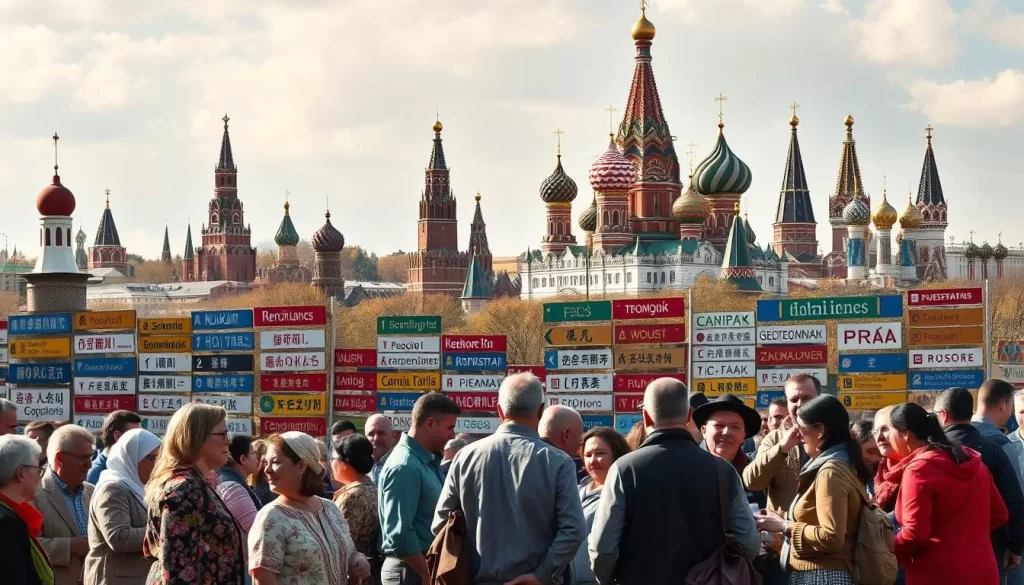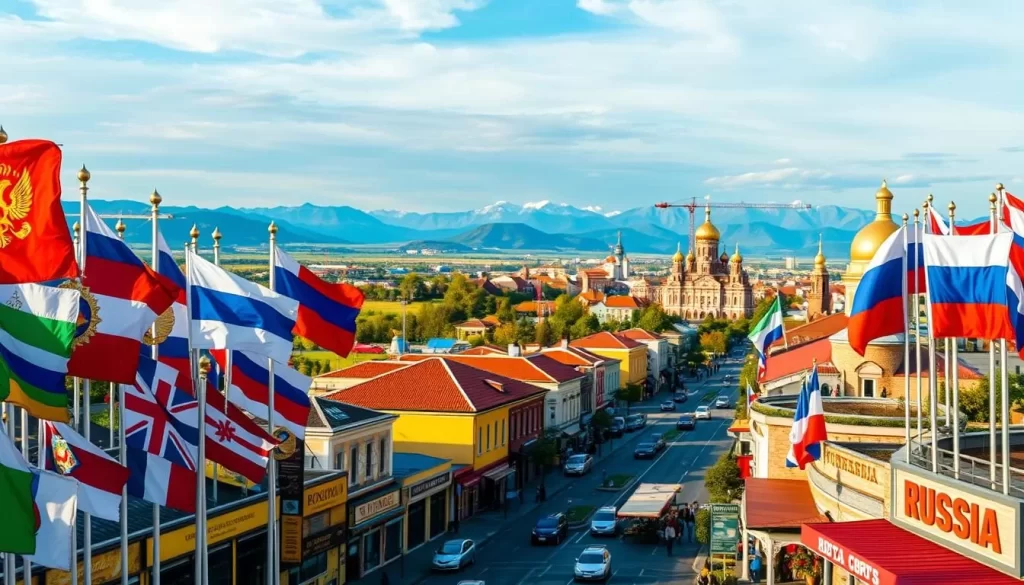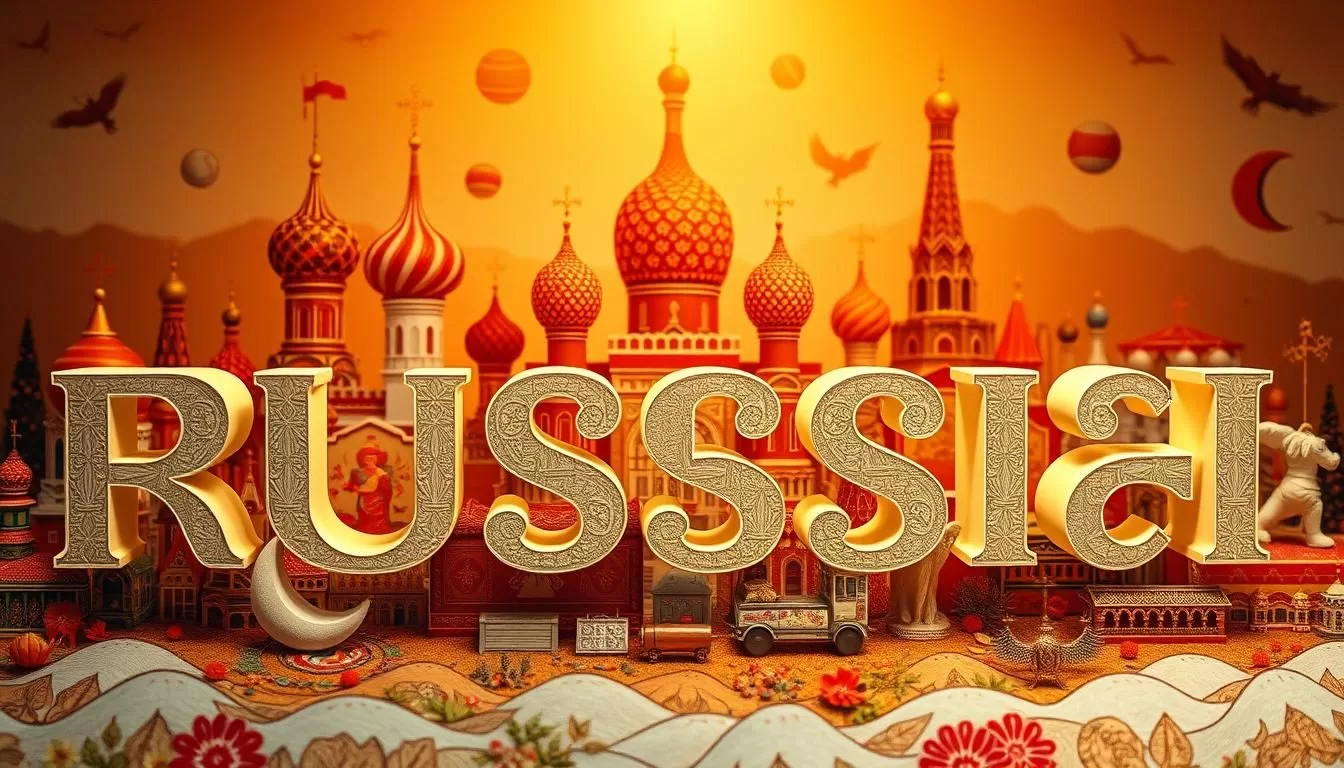✓ Accommodations✓ Flights✓ Rental Cars
When you think of Russia, the first thing that comes to mind might be its rich culture and history. But did you know the country is also home to a fascinating linguistic landscape? Russian is the only official language at the national level, serving as a unifying force across its vast territory.
Beyond Russian, there are 25 other official languages recognized in various regions. These reflect the diverse ethnic groups that make up the population. The 2010 census provides valuable insights into language usage, showing how Russian dominates while regional languages hold their ground.
Understanding this linguistic diversity offers a deeper appreciation of the country’s heritage. Whether you’re exploring its cities or studying its history, knowing about its languages opens doors to new knowledge.
Exploring Russia’s Linguistic Landscape
The linguistic diversity of this vast nation tells a story of history, culture, and identity. Over centuries, policies and societal shifts have shaped the way people communicate. Understanding this evolution offers a deeper look into its heritage.

Historical Context and Russification
After the Soviet Union dissolved, many regional languages lost their status. Russification policies, aimed at promoting Russian as the dominant language, impacted indigenous communities. For example, in the North Caucasus, languages like Chechen and Avar faced challenges in maintaining their presence.
Historical records show a shift from Arabic to Cyrillic script for some languages. This change reflects broader efforts to unify the population under a single linguistic identity. The 2010 census highlights how these policies influenced the number of speakers for minority languages.
Modern Multilingual Communities
Today, multilingualism thrives in many cities. Tatar, with over 5.5 million speakers, remains one of the most widely spoken minority languages. Similarly, Bashkir and Chuvash continue to hold strong cultural significance in their respective regions.
Government actions have played a role in preserving these languages. Dictionaries and educational programs aim to keep them alive for future generations. The rise of modern multilingual communities showcases resilience and adaptability.
From the bustling streets of Moscow to the remote villages of Yakutia, the linguistic landscape is a testament to the nation’s rich cultural tapestry. Exploring it offers a window into its past and present.
Understanding Russia’s Official Language Policies
Language policies in this vast country reveal a complex balance between unity and diversity. While the Russian language holds federal status, many regions have established their own official languages. This dual system reflects the nation’s commitment to both national cohesion and cultural preservation.
Federal Versus Regional Language Status
At the federal level, Russian is the sole official language. However, regions like Tatarstan and Dagestan have adopted additional languages. For example, Tatar is widely spoken in Tatarstan, with over 5.3 million speakers. This regional autonomy allows local communities to maintain their linguistic heritage.
The 2010 census provides valuable insights into these differences. It shows how speaker numbers vary across regions, highlighting the importance of local policies. In Dagestan, for instance, multiple languages coexist, each with its own cultural significance.
Dictionaries, alphabets, and scripts play a crucial role in preserving these languages. For example, the Cyrillic script is used for many regional languages, ensuring they remain accessible to speakers. These tools help bridge the gap between tradition and modernity.
Understanding these policies offers a deeper appreciation of the country’s linguistic landscape. Whether you’re exploring federal laws or regional practices, the interplay between unity and diversity is evident.
Russia: Official and widely spoken languages
Exploring the linguistic diversity of this vast country reveals a rich tapestry of cultures and histories. Beyond the national official language, 25 regional languages hold official status in various republics. These languages reflect the unique identities of their speakers and are deeply rooted in their respective regions.

Languages like Tatar, Chechen, and Bashkir are among the most widely spoken. Tatar, for example, boasts over 5.2 million speakers, while Chechen has around 1.3 million. These numbers highlight the cultural significance of these minority languages.
Language Families and Speaker Statistics
The 2010 census provides a detailed record of speaker numbers. Languages like Ukrainian, Chuvash, and Avar each have hundreds of thousands of speakers. This data underscores the importance of preserving these languages through dictionaries and educational programs.
Here’s a quick look at some key languages and their families:
- Tatar: Turkic family, 5.2 million speakers
- Chechen: Northeast Caucasian family, 1.3 million speakers
- Bashkir: Turkic family, 1.45 million speakers
Preservation Through Documentation
Efforts to document these languages include the creation of dictionaries and the use of specific scripts. For example, many regional languages use the Cyrillic script, ensuring accessibility for speakers. These tools play a crucial role in maintaining linguistic heritage.
Regional policies also support language preservation. In republics like Tatarstan and Dagestan, local languages are taught in schools and used in official documents. This dual system of language use highlights the balance between national unity and cultural diversity.
Understanding these languages offers a deeper appreciation of the country’s cultural richness. Whether you’re exploring a bustling city or a remote village, the linguistic landscape tells a story of resilience and identity.
Diverse Language Families and Their Cultural Roots
The rich tapestry of languages in this region reflects centuries of cultural exchange and historical evolution. From the Turkic family to Slavic and Indo-European influences, each language tells a story of identity and heritage. Understanding these roots offers a deeper appreciation of the region’s diversity.

Turkic, Slavic, and Indo-European Influences
The Turkic family includes languages like Tatar and Bashkir, spoken by millions. Tatar, with over 4.2 million native speakers, is the second most common language in the region. Similarly, Bashkir is spoken by over 1.1 million people, holding strong cultural significance in Bashkortostan.
Slavic languages, such as Ukrainian, are also prominent. Ukrainian has 1.1 million speakers, making it the second most spoken Slavic language globally. Indo-European influences are evident in Russian, which has evolved significantly over centuries.
Caucasian, Uralic, and Other Language Families
Caucasian languages like Chechen have deep cultural roots. With over 1.3 million speakers, Chechen holds official status in multiple republics. Uralic languages, such as Chuvash, are unique, being the only preserved language of the Oghur branch of Turkic languages.
Efforts to preserve these languages include the use of dictionaries and specific scripts. For example, many regional languages have shifted from Arabic to Cyrillic script, ensuring accessibility for speakers. These tools play a crucial role in maintaining linguistic heritage.
If you’re interested in learning more about the evolution of these languages, check out this detailed guide on their historical development.
Impact of Government Policies & Language Education
Government actions shape the way communities preserve their linguistic heritage. Policies often influence how minority languages are taught and used in daily life. For example, the 2018 education bill reduced teaching hours for indigenous languages, sparking protests across the country.

These changes highlight the tension between promoting a unified national language and preserving regional identities. Understanding this balance is key to appreciating the complexities of language education.
Insights from the 2010 Census and Beyond
The 2010 census provides valuable data on language usage. It shows how government policies have impacted the number of speakers for minority languages. For instance, in northeast Caucasian regions, languages like Chechen and Avar face challenges in maintaining their presence.
Efforts to document these languages include the creation of dictionaries and the use of specific scripts. Many regional languages have shifted to the Cyrillic alphabet, ensuring accessibility for speakers. These tools play a crucial role in maintaining linguistic heritage.
Modern Trends in Minority Language Usage
Modern trends reveal a mix of resilience and decline. In North Ossetia, for example, minority language speakers continue to advocate for their cultural rights. However, the 2018 education reforms have made it harder for these languages to thrive in schools.
Despite these challenges, some communities are finding innovative ways to keep their languages alive. Bilingual education programs and cultural initiatives are helping to bridge the gap between tradition and modernity.
For more insights into how these policies affect language education, explore this detailed analysis of sociolinguistic dynamics in the region.
Conclusion
The linguistic landscape of this vast country is a testament to its rich cultural heritage. With Russian as the official language, it serves as a unifying force across diverse regions. However, the presence of over 150 minority languages highlights the nation’s commitment to preserving its cultural roots.
Data from the 2010 census reveals that while Russian dominates, languages like Tatar and Chechen continue to thrive in their respective republics. These languages are not just tools of communication but markers of identity and history.
Efforts to document and revitalize indigenous languages are ongoing. Programs in education and cultural preservation aim to keep these languages alive for future generations. Despite challenges, many communities remain resilient in maintaining their linguistic heritage.
Understanding this diversity offers a deeper appreciation of the country’s cultural tapestry. Whether you’re exploring its cities or studying its history, the linguistic landscape tells a story of resilience and identity. For more insights, visit this detailed guide on indigenous languages.
The above is subject to change.
Check back often to TRAVEL.COM for the latest travel tips and deals.






